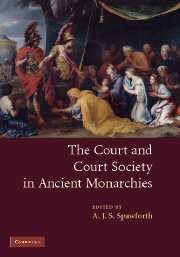Book contents
- Frontmatter
- Contents
- List of figures
- List of tables
- Notes on contributors
- Acknowledgements
- List of abbreviations
- Introduction
- 1 New out of old? Court and court ceremonies in Achaemenid Persia
- 2 King, court and royal representation in the Sasanian empire
- 3 The court of Alexander the Great between Europe and Asia
- 4 Friends in high places: the creation of the court of the Roman emperor
- 5 The imperial court of the late Roman empire, C. AD 300–C. AD 450
- 6 The imperial court in Han China
- 7 Court and palace in ancient Egypt: the Amarna period and later Eighteenth Dynasty
- Bibliography
- Index
Introduction
Published online by Cambridge University Press: 22 September 2009
- Frontmatter
- Contents
- List of figures
- List of tables
- Notes on contributors
- Acknowledgements
- List of abbreviations
- Introduction
- 1 New out of old? Court and court ceremonies in Achaemenid Persia
- 2 King, court and royal representation in the Sasanian empire
- 3 The court of Alexander the Great between Europe and Asia
- 4 Friends in high places: the creation of the court of the Roman emperor
- 5 The imperial court of the late Roman empire, C. AD 300–C. AD 450
- 6 The imperial court in Han China
- 7 Court and palace in ancient Egypt: the Amarna period and later Eighteenth Dynasty
- Bibliography
- Index
Summary
Taking the field of ancient history as a whole, including the Middle and Far East as well as Europe and the Mediterranean, the monarchical court cannot be said to have occupied centre-stage in a way that might seem justified by the prevalence of monarchy as a system of power in antiquity. The reasons for this relative neglect are complex and cannot all be unpacked here. But one, certainly, is the sense of the court as a ‘moribund social formatio[n]’ which has permeated western consciousness since the French Revolution. Backstairs influence, intrigue and flattery: these generic phenomena of courts have earned themselves a bad reputation in western democracies which pose as the mirror-opposites of ‘old-regime’ arrangements of power, and in the study of ancient monarchies they are often sidelined, or their association by ancient writers with ‘bad’ or ‘weak’ rulers, or with whole societies classed as degenerate, as the ancient Persians were by the ancient Greeks (Brosius in this volume), taken at face value. In those nineteenth-century European monarchies which survived, especially after 1848, constitutionalism was the order of the day, as it had been (at least notionally) in the United Kingdom since 1688. Perhaps unsurprisingly, then, in the nineteenth and for much of the twentieth century the students of monarchical institutions in the ancient world have often been preoccupied with modernist attempts to define their legal basis – as with the Macedonian kings, say, or the early Roman emperors.
- Type
- Chapter
- Information
- The Court and Court Society in Ancient Monarchies , pp. 1 - 16Publisher: Cambridge University PressPrint publication year: 2007
- 2
- Cited by

